Theme Parks & Themed Entertainment
Disneyland’s Floral Mickey: Six Days Before Opening
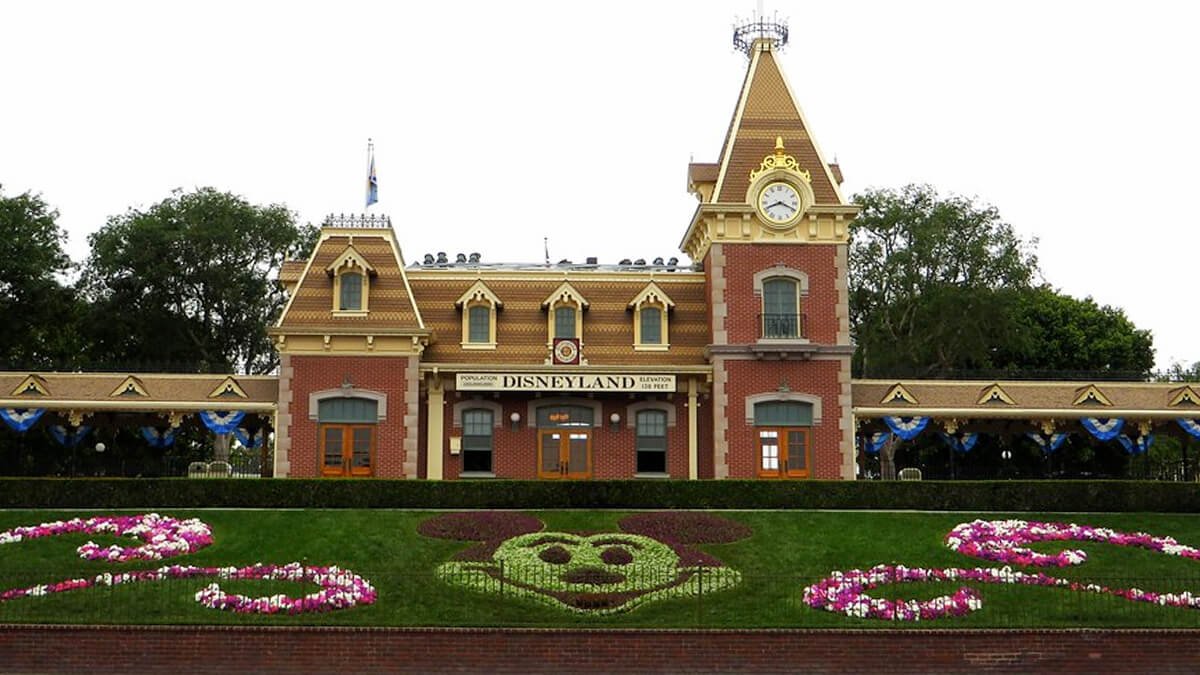
According to Kodak (circa 1985. Disneyland’s 30th anniversary), the Floral Mickey in front of the Main Street Train Station at Disneyland Park is one of the most photographed locations in the world. Only the Taj Mahal & the Eiffel Tower gets more pictures taken on them annually.
Tourists, as they enter that family fun park, typically get in line as soon as they come through the turnstiles. Just so they can then get that “We were there” shot (Especially these days, in our “if-you-don’t-have-pics-it-didn’t-happen” age).
Given how many people get their pictures taken in front of the Floral Mickey, the Horticulture and Resort Enhancement Team at Disneyland Park make sure that they always keep it looking its best.
How Often is The Floral Mickey Replanted Each Year?
This typically involves replanting the Floral Mickey 9 times a year.
This process that is typically done on third shift so that Mickey always looks his best whenever Guests show up at the Park.
How Many Flowers is in The Floral Mickey at Disneyland?
Every time that Floral Mickey gets replanted, between the floral filigrees & flourishes off to the side of Mickey’s face and the annuals that need to be replaced within the actual borders of his massive mouse face, you’re typically talking 9,000 flowers.
To put that in perspective: Every year, the horticultural department at Disneyland Park, in order to maintain that theme park’s 7 total acres of annual beds, has to bring a million flowers in from outside greenhouses. And almost a tenth of those annuals this family fun park buys annually are used just to keep that Floral Mickey looking sharp.
Creating the First Floral Mickey at Disneyland
Were we to jump back some 66 years to less than 6 days before Disneyland Park first opened to the public, the Floral Mickey had yet to be planted.
Which genuinely concerned Joe Fowler. Who was the Park Construction Administrator for Walt’s family fun park. Which is why on July 11, 1955 Joe sent a memo to Jack Evans (who, along with his brother Morgan “Bill” Evans, was handling a lot of Disneyland’s horticultural aspects).
That memo read:
When are you going to plant Mickey Mouse in the entrance? Looks to me like the time is getting pretty late.
Joe fowler – July 11, 1955
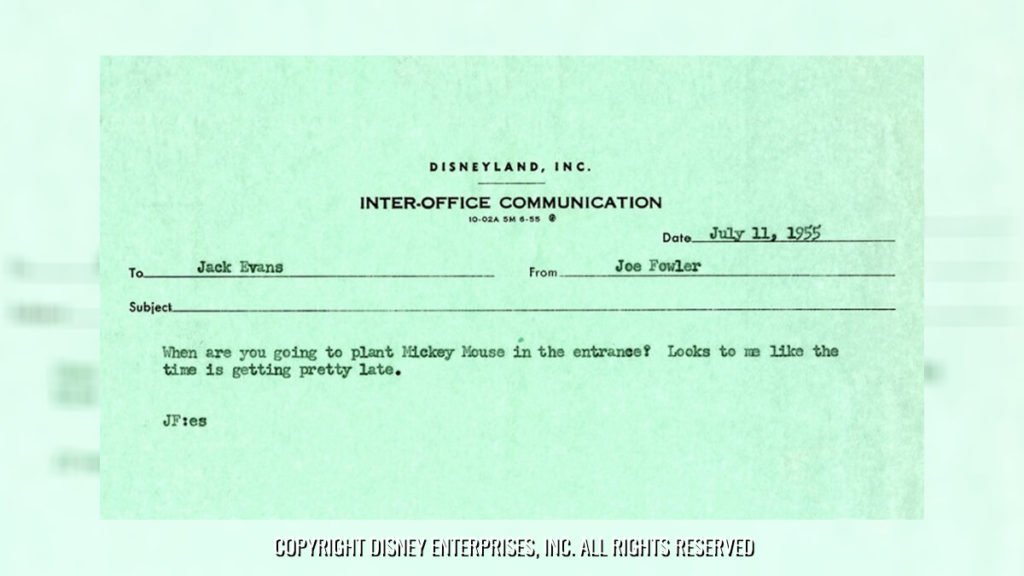
Walt Disney’s Original Plan for a Floral Mickey
A Floral Mickey dates as far back as 1953. When Disneylandia was supposed to be built on the other side of Riverside Drive, just across from the Disney Lot in Burbank, the front entrance of Walt’s family fun park was supposed to have had a Floral Mickey.
To Walt’s way of thinking, this floral element was the equivalent of that pie-eyed Mickey you saw surrounded by a sunburst at the start of every technicolor Mickey Mouse cartoon from the 1930s. It was a Disney-specific way of saying “Welcome! You’re in for a good time today”.
Why Wait Until the Last Minute: Problems at Disneyland
Why was this part of the Disneyland project not started ‘til the very last minute? Well, there are a couple of reasons.
Money got very, very tight towards the end of Disneyland’s construction. And one of the areas that got really impacted by this ever-tightening budget was the horticultural aspects of this project.
At the 10th anniversary party for Disneyland, Walt told the story about how, when money ran out to landscape large sections of Tomorrowland, Bill Evans just had signs & labels made up for the weeds that grew naturally at the construction site. Bill had these signs made up with the full Latin names of each of these weeds. So that when Guests looked at them they’d then think “Oh, these plants must have been deliberately planted like that. What an unusual idea.
But there was another key reason that the Floral Mickey hadn’t been planted in front of the Main Street Train Station by July 11, 1955 (just 6 days before the big live broadcast on ABC of “Dateline Disneyland.” And it’s something that The Walt Disney Company really doesn’t like to talk about.
A turf war broke out at the Disneyland construction site in Anaheim in the Spring of 1955 when it came to who would decide what would get planted where at Walt’s family fun park.
Professional Landscapers: Bill & Jack Evans – and Ruth Shellhorn
To understand what happened here, we have to go back to 1949. Walt purchased a lot on Carolwood Drive in the Holmby Hills neighborhood of Los Angeles. It was here that Disney would build his 1/8th scale Carolwood Pacific Railway (which included a 90-foot-long stretch of tunnel that took Walt’s guests under his wife Lily’s flowerbeds).
Bill and Jack Evans
Because Lillian insisted that, to avoid annoying their new neighbors in Holmby Hills, Walt had to hide as much of his backyard steam train set-up away from prying eyes as possible. He then hired the Evans & Reeves nursery in West Los Angeles to come landscape his property. And Walt was supposedly so pleased with the work that Bill Evans and his brother Jack had done that, when the Disneyland project finally got funded in 1954, Disney reached out to the Evans again and invited them to come on out to Anaheim and turn 160 acres of what used to be orange groves & walnut trees into a highly themed, beautifully landscaped family fun park.
The only problem here was the Evans weren’t professionally trained landscapers.
Bill had gone to Stanford University in the 1920s to study engineering. More to the point, while they had done plantings at the homes of some of the biggest stars in Hollywood – Greta Garbo, Clark Gable & Elizabeth Taylor among them – Bill & Jack had never done anything of this size before. I mean, this wasn’t going to be some sort of elaborate backyard garden at a private home. Disneyland was going to be this vast commercial enterprise that thousands of people would enter every day. The daily wear & tear on this family fun park’s ornamental trees & flower beds was going to be extraordinary.
Finally realizing that, while Walt obviously personally liked Bill & Jack, the Evans were kind of in over their heads when it came to the Disneyland project.
Walt then reached to Walter Becket (the architect that Disney had originally consulted when he was first thinking of building Disneylandia). This was the late Winter / early Spring of 1955 (roughly 5 months out from the grand opening of Disneyland) and asked if Beckett had a landscape architect that he could recommend. Someone who had enough professional experience to tackle a horticultural project of this size.
Introducing Ruth Shellhorn
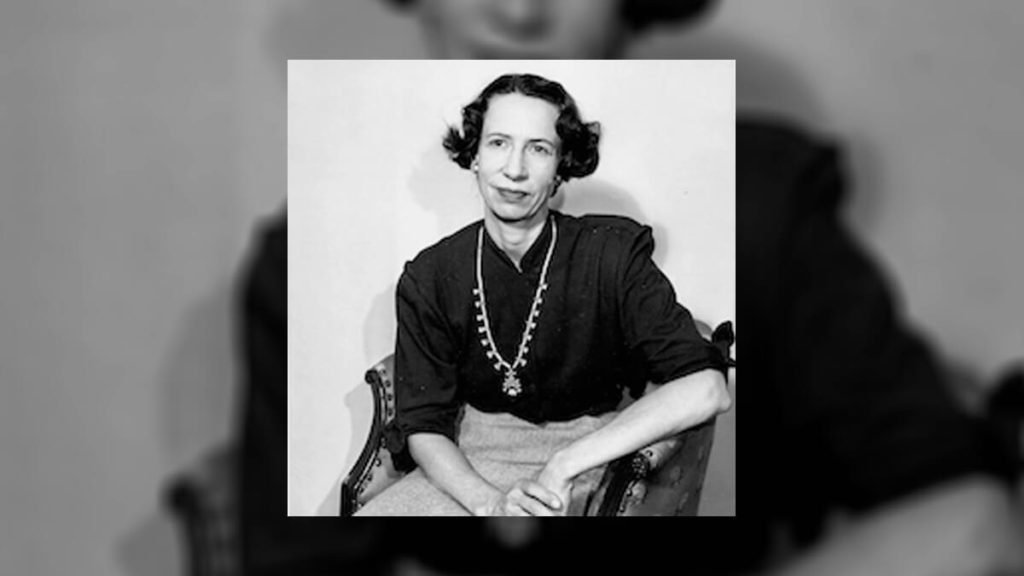
Walter immediately recommended Ruth Shellhorn. Shellhorn was a Los Angeles native who had attended Oregon State University’s School of Landscape Architecture before she then continued with her studies at Cornell. In the early 1950s, Ruth had been the landscape architect for a string of Bullock’s shopping plazas, where she combined elements of park planning with the suburban mall. In short, Shellhorn had done projects of size before like Disneyland Park which had to accommodate the movement of thousands of people every day.
Given that there was something of a ticking clock here (More importantly, given that it was absolutely crucial that Disneyland’s Jungle Cruise ride be surrounded by this deep, thick, totally authentic-looking forest full of exotic plants when this Adventureland attraction opened in July of 1955), a command decision was made:
Ruth would concentrate on completing Disneyland’s entrance (which obviously included that Floral Mickey), Main Street U.S.A., the area around the Hub and Sleeping Beauty Castle as well as the entrance to Tomorrowland. Bill & Jack will then concentrate on completing Adventureland’s Jungle Cruise as well as the planting which was already underway in & around Frontierland.
Landscaping Troubles
The problem here was Ruth Shellhorn was a late arrival to the Disneyland Project. More to the point, she was a professional when it came to the world of landscape architecture. Which is why, Shellhorn handed down orders out in the field to the guys who were driving the bulldozers around that Anaheim construction site, Ruth then expected those orders to be followed.
Now the onsite construction team, they’d been following the order of the Evans up until this time. And then suddenly there was this new woman there asking them to regrade things that had supposedly been completed weeks earlier. As a direct result, there was a certain amount of carping & complaining coming from the Disneyland construction team. And initially things didn’t get done as quickly as Shellhorn would have liked.
So Ruth went to Walt and then Walt lowered the boom at the Disneyland construction site.
He made it exceedingly clear that, from here-on in, Shellhorn’s orders while she was out on the field were to be followed to the letter. Because it was crucial that Disneyland Park make its previously announced July 17th opening date.
Butting Heads with Walt
The problem was, as Disneyland’s opening date kept getting closer & closer and the budget for this ambitious project got tighter & tighter, Ruth’s follow-my-orders-precisely attitude began to butt heads with Walt’s far more casual attitude. After all, Disney had dreamed up this whole project. And when he was at the construction site and see something that he didn’t like, Walt would then ask workers in the field to pull up survey stakes and shift a walkway 10 feet to the left. Or ask for a tree to be ripped out so that it then wouldn’t block the view of Sleeping Beauty Castle.
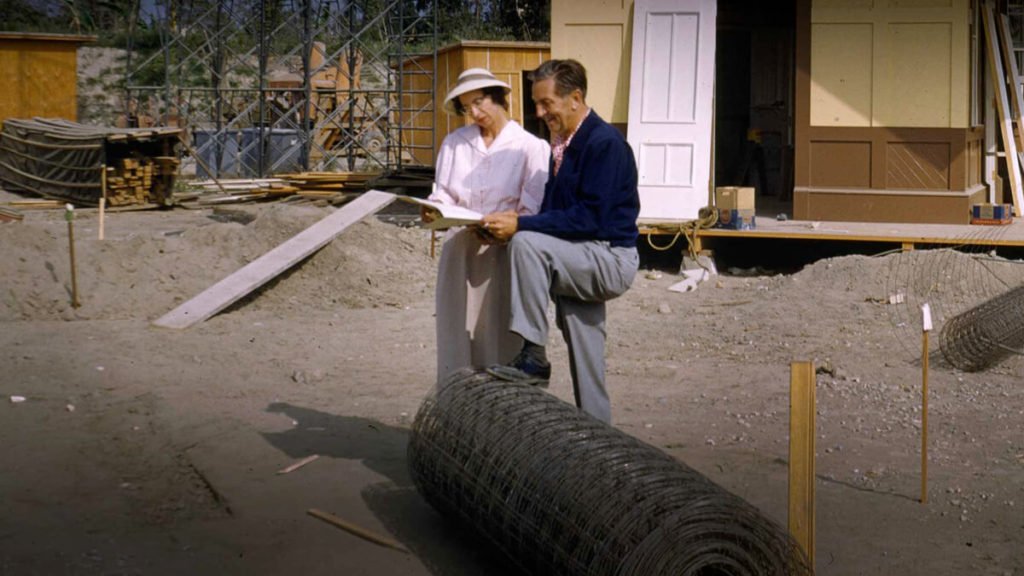
This often put Ruth Shellhorn at odds with Walt. I mean, Shellhorn understood that in the end, it’s the client’s wishes that need to be followed. But so many of these sorts of decisions, especially during the final weeks of construction on Disneyland, were made on the fly out in the field – with Ruth learning well after the fact. Which then meant that she needed to adjust all of her carefully crafted landscaping plans for this family fun park at the very last minute. Which was aggravating & stressful.
On the other hand, the Evans, who were already familiar with Walt’s ways after having landscaped the Disney family home in Holmby Hills in late 1949 / early 1950, just rolled with the punches. Whatever Walt asked them to do at the Disneyland construction site, Bill & Jack did – no questions asked.
Mind you, when the Evans missed deadlines (They spent so much time concentrating on making Adventureland look like the best jungle north of Costa Rica that Bill & Jack neglected Frontierland), Shellhorn picked up the slack. In the final ten days of construction, she created landscapes designs for three different areas in Frontierland. Ruth even got down in the dirt herself to help with the planting of seedlings.
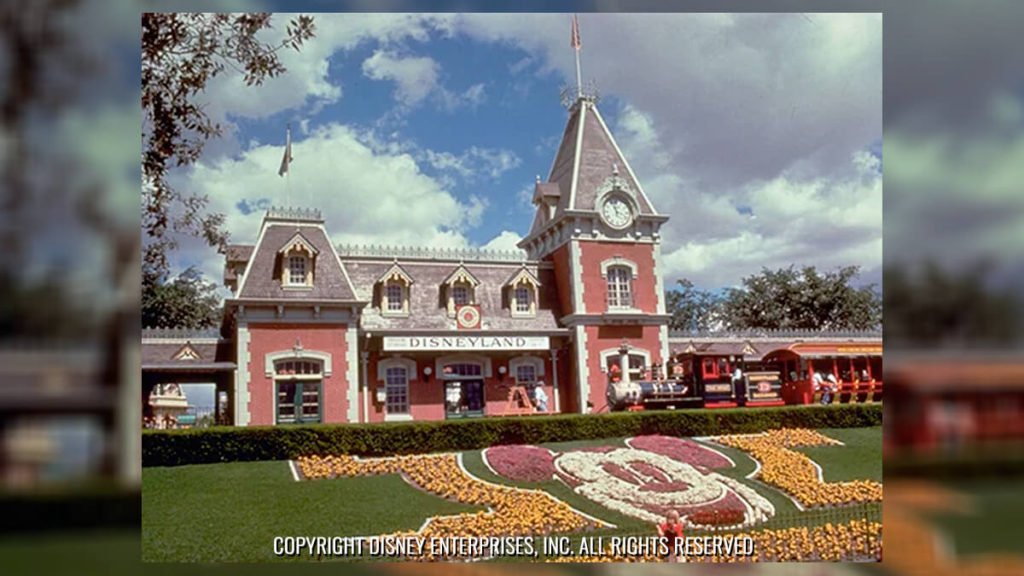
The Floral Mickey Ready for Disneyland’s Opening Day
Shellhorn’s very hands-on attitude even extended to Disneyland’s Floral Mickey. Ruth had put a lot of advance thought into this project. She’d put together a palette of bright seasonal annuals that would then really make this massive mouse’s face pop with color, such as dwarf pink phlox for Mickey’s tongue.
By the way, after Joe Fowler’s memo to Jack Evans on July 11th … Bill supposed built & then installed the framework for Mickey’s face in that hillside directly below the Main Street Train Station on July 13th. Ruth then directed the planting of those thousands of colorful annuals into the framework that formed the floral Mickey on July 15th. And two days later, at the very start of “Dateline Disneyland,” Art Linkletter stood in front of that Floral Mickey and welcomed television viewers around the globe to Walt’s family fun park.
Opening Day Aftermath
Yes, because things were done so close to deadline, things got stressful. Perhaps too stressful. Just two weeks after Disneyland Park opened, Jack Evans suffered a massive heart attack. He never returned to the field after that. He stayed back at the Evans & Reaves Nursery and mostly handled paperwork from there on in. But even that proved to be too much for Jack. After another cardiac episode, he passed away in 1958.
Perhaps unfairly, the fact that the horticultural aspect of the Disneyland project had gotten so stressful towards the end of its construction was placed at the feet of Ruth Shellhorn. One might argue that, because the construction teams in Anaheim had initially been so tough of her, Shellhorn then had to push back. Be as tough as they were.
Bill Evans, Disney Legend (1992)
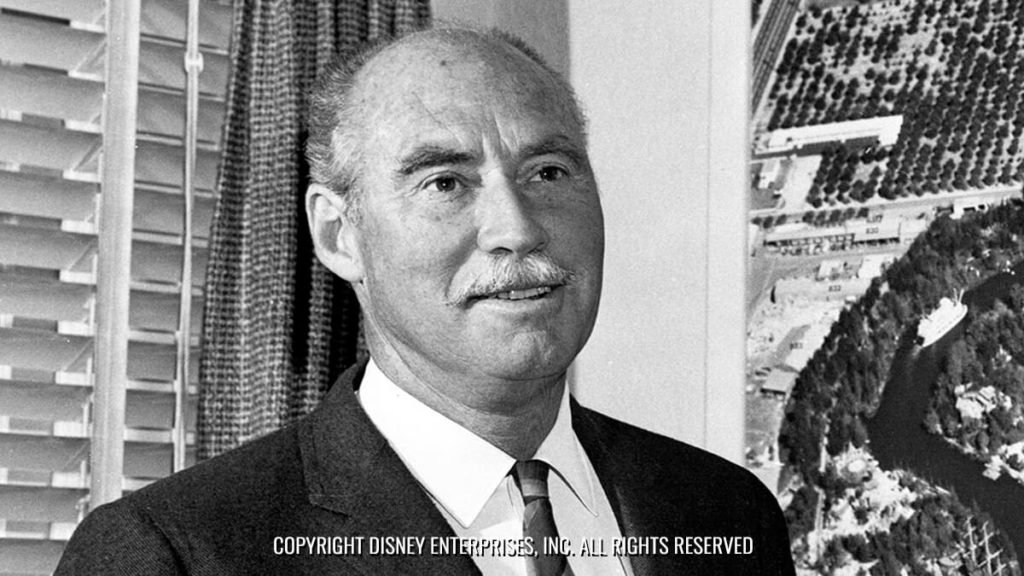
Walt felt just terrible about what happened to Jack. He wound up throwing a lot of work Bill’s way. So much so that Evans would eventually go on design the landscape of Disney’s theme parks for the next half a century. I mean, even though Bill officially retired from the Mouse House in 1975, the Company kept calling him back to consult on every theme park they built after that. Right up until Hong Kong Disneyland (which would open in September of 2005). Bill died three years prior to the opening of that theme park at the age of 92.
From the planning of Disneyland to consulting in the planning for Hong Kong Disneyland, expected to open three years from now, has died. He was 92.
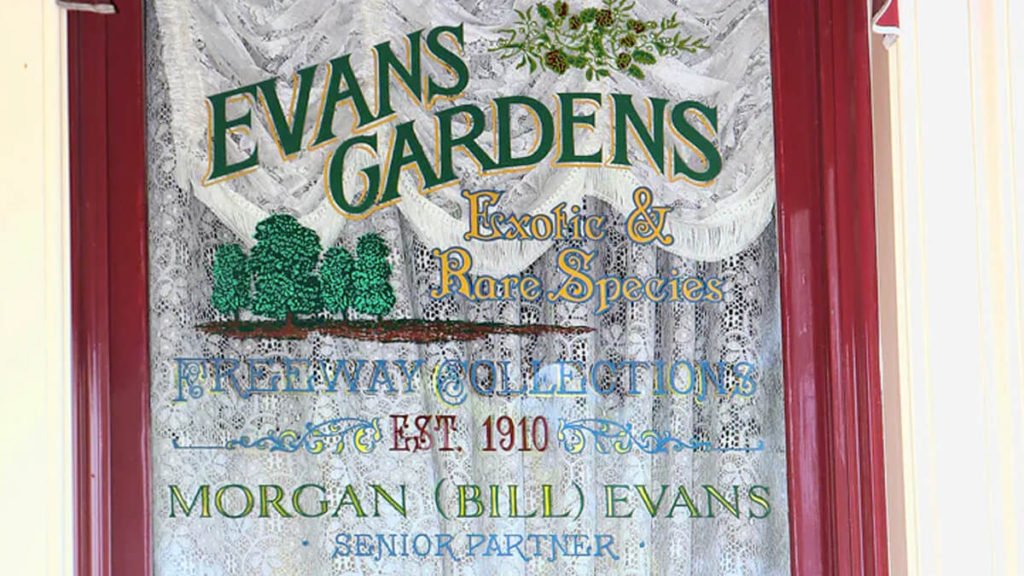
Ruth Shellhorn
As for Ruth Shellhorn, the talented landscape architect who’d come in at virtually the last minute and helped Disneyland Park to open on time, she wasn’t invited to stay on the project. Ruth moved on to other things.
Mind you, Shellhorn’s involvement in the creation of Disneyland is acknowledged. In certain spots. You just have to know where to look for them. There’s that “Disneyland – World of Flowers” book (which was published back in 1965 as part of that theme park’s tencennial).
In the foreword that Disney personally wrote for this hardcover, Walt said:
In giving credit for the landscaping at the Park, it is impossible to mention all who have contributed. Special plaudits are due to Ruth Patricia Shellhorn for her design of the formal Victorian plan for Main Street, the Town Square, and the Plaza. The trees and shrubs she selected in the spring of 1955 are still used today.
Walt disney, 1965
Which includes that Floral Mickey right below the Main Street Train Station. Which, again, only got planted just days before Walt’s family fun park first opened to the public and then went on to become one of the most photographed things in the world.
Not bad for something that was thrown together at the very last moment.
Just keep that in mind when you start a book report that’s due on Monday morning on Sunday night.
History
The Evolution and History of Mickey’s ToonTown

Disneyland in Anaheim, California, holds a special place in the hearts of Disney fans worldwide, I mean heck, it’s where the magic began after all. Over the years it’s become a place that people visit in search of memorable experiences. One fan favorite area of the park is Mickey’s Toontown, a unique land that lets guests step right into the colorful, “Toony” world of Disney animation. With the recent reimagining of the land and the introduction of Micky and Minnies Runaway Railway, have you ever wondered how this land came to be?
There is a fascinating backstory of how Mickey’s Toontown came into existence. It’s a tale of strategic vision, the influence of Disney executives, and a commitment to meeting the needs of Disney’s valued guests.
The Beginning: Mickey’s Birthdayland
The story of Mickey’s Toontown starts with Mickey’s Birthdayland at Walt Disney World’s Magic Kingdom. Opened in 1988 to celebrate Mickey Mouse’s 60th birthday, this temporary attraction was met with such overwhelming popularity that it inspired Disney executives to think bigger. The idea was to create a permanent, immersive land where guests could step into the animated world of Mickey Mouse and his friends.
In the early ’90s, Disneyland was in need of a refresh. Michael Eisner, the visionary leader of The Walt Disney Company at the time, had an audacious idea: create a brand-new land in Disneyland that would celebrate Disney characters in a whole new way. This was the birth of Mickey’s Toontown.
Initially, Disney’s creative minds toyed with various concepts, including the idea of crafting a 100-Acre Woods or a land inspired by the Muppets. However, the turning point came when they considered the success of “Who Framed Roger Rabbit.” This film’s popularity and the desire to capitalize on contemporary trends set the stage for Toontown’s creation.
From Concept to Reality: The Birth of Toontown
In 1993, Mickey’s Toontown opened its gates at Disneyland, marking the first time in Disney Park history where guests could experience a fully realized, three-dimensional world of animation. This new land was not just a collection of attractions but a living, breathing community where Disney characters “lived,” worked, and played.
Building Challenges: Innovative Solutions
The design of Mickey’s Toontown broke new ground in theme park aesthetics. Imagineers were tasked with bringing the two-dimensional world of cartoons into a three-dimensional space. This led to the creation of over 2000 custom-built props and structures that embodied the ‘squash and stretch’ principle of animation, giving Toontown its distinctiveness.
And then there was also the challenge of hiding the Team Disney Anaheim building, which bore a striking resemblance to a giant hotdog. The Imagineers had to think creatively, using balloon tests and imaginative landscaping to seamlessly integrate Toontown into the larger park.

Key Attractions: Bringing Animation to Life
Mickey’s Toontown featured several groundbreaking attractions. “Roger Rabbit’s Car Toon Spin,” inspired by the movie “Who Framed Roger Rabbit,” became a staple of Toontown, offering an innovative ride experience. Gadget’s Go-Coaster, though initially conceived as a Rescue Rangers-themed ride, became a hit with younger visitors, proving that innovative design could create memorable experiences for all ages.
Another crown jewel of Toontown is Mickey’s House, a walkthrough attraction that allowed guests to explore the home of Mickey Mouse himself. This attraction was more than just a house; it was a carefully crafted piece of Disney lore. The house was designed in the American Craftsman style, reflecting the era when Mickey would have theoretically purchased his first home in Hollywood. The attention to detail was meticulous, with over 2000 hand-crafted, custom-built props, ensuring that every corner of the house was brimming with character and charm. Interestingly, the design of Mickey’s House was inspired by a real home in Wichita Falls, making it a unique blend of real-world inspiration and Disney magic.
Mickey’s House also showcased Disney’s commitment to creating interactive and engaging experiences. Guests could make themselves at home, sitting in Mickey’s chair, listening to the radio, and exploring the many mementos and references to Mickey’s animated adventures throughout the years. This approach to attraction design – where storytelling and interactivity merged seamlessly – was a defining characteristic of ToonTown’s success.

Executive Decisions: Shaping ToonTown’s Unique Attractions
The development of Mickey’s Toontown wasn’t just about creative imagination; it was significantly influenced by strategic decisions from Disney executives. One notable input came from Jeffrey Katzenberg, who suggested incorporating a Rescue Rangers-themed ride. This idea was a reflection of the broader Disney strategy to integrate popular contemporary characters and themes into the park, ensuring that the attractions remained relevant and engaging for visitors.
In addition to Katzenberg’s influence, Frank Wells, the then-President of The Walt Disney Company, played a key role in the strategic launch of Toontown’s attractions. His decision to delay the opening of “Roger Rabbit’s Car Toon Spin” until a year after Toontown’s debut was a calculated move. It was designed to maintain public interest in the park by offering new experiences over time, thereby giving guests more reasons to return to Disneyland.
These executive decisions highlight the careful planning and foresight that went into making Toontown a dynamic and continuously appealing part of Disneyland. By integrating current trends and strategically planning the rollout of attractions, Disney executives ensured that Toontown would not only capture the hearts of visitors upon its opening but would continue to draw them back for new experiences in the years to follow.
Global Influence: Toontown’s Worldwide Appeal
The concept of Mickey’s Toontown resonated so strongly that it was replicated at Tokyo Disneyland and influenced elements in Disneyland Paris and Hong Kong Disneyland. Each park’s version of Toontown maintained the core essence of the original while adapting to its cultural and logistical environment.
Evolution and Reimagining: Toontown Today
As we approach the present day, Mickey’s Toontown has recently undergone a significant reimagining to welcome “Mickey & Minnie’s Runaway Railway” in 2023. This refurbishment aimed to enhance the land’s interactivity and appeal to a new generation of Disney fans, all while retaining the charm that has made ToonTown a beloved destination for nearly three decades.

Dive Deeper into ToonTown’s Story
Want to know more about Mickey’s Toontown and hear some fascinating behind-the-scenes stories, then check out the latest episode of Disney Unpacked on Patreon @JimHillMedia. In this episode, the main Imagineer who worked on the Toontown project shares lots of interesting stories and details that you can’t find anywhere else. It’s full of great information and fun facts, so be sure to give it a listen!
History
Unpacking the History of the Pixar Place Hotel

Pixar Place Hotel, the newly unveiled 15-story tower at the Disneyland Resort, has been making waves in the Disney community. With its unique Pixar-themed design, it promises to be a favorite among visitors.
However, before we delve into this exciting addition to the Disneyland Resort, let’s take a look at the fascinating history of this remarkable hotel.
The Emergence of the Disneyland Hotel
To truly appreciate the story of the Pixar Place Hotel, we must turn back the clock to the early days of Disneyland. While Walt Disney had the visionary ideas and funding to create the iconic theme park, he faced a challenge when it came to providing accommodations for the park’s visitors. This is where his friend Jack Wrather enters the picture.
Jack Wrather, a fellow pioneer in the television industry, stepped in to assist Walt Disney in realizing his dream. Thanks to the success of the “Lassie” TV show produced by Wrather’s company, he had the financial means to build a hotel right across from Disneyland.
The result was the Disneyland Hotel, which opened its doors in October 1955. Interestingly, the early incarnation of this hotel had more of a motel feel than a hotel, with two-story buildings reminiscent of the roadside motels popular during the 1950s. The initial Disneyland Hotel consisted of modest structures that catered to visitors looking for affordable lodging close to the park. While the rooms were basic, it marked the beginning of something extraordinary.
The Evolution: From Emerald of Anaheim to Paradise Pier
As Disneyland’s popularity continued to soar, so did the demand for expansion and improved accommodations. In 1962, the addition of an 11-story tower transformed the Disneyland Hotel, marking a significant transition from a motel to a full-fledged hotel.
The addition of the 11-story tower elevated the Disneyland Hotel into a more prominent presence on the Anaheim skyline. At the time, it was the tallest structure in all of Orange County. The hotel’s prime location across from Disneyland made it an ideal choice for visitors. With the introduction of the monorail linking the park and the hotel, accessibility became even more convenient. Unique features like the Japanese-themed reflecting pools added to the hotel’s charm, reflecting a cultural influence that extended beyond Disney’s borders.
Japanese Tourism and Its Impact
During the 1960s and 1970s, Disneyland was attracting visitors from all corners of the world, including Japan. A significant number of Japanese tourists flocked to Anaheim to experience Walt Disney’s creation. To cater to this growing market, it wasn’t just the Disneyland Hotel that aimed to capture the attention of Japanese tourists. The Japanese Village in Buena Park, inspired by a similar attraction in Nara, Japan, was another significant spot.
These attractions sought to provide a taste of Japanese culture and hospitality, showcasing elements like tea ceremonies and beautiful ponds with rare carp and black swans. However, the Japanese Village closed its doors in 1975, likely due to the highly competitive nature of the Southern California tourist market.
The Emergence of the Emerald of Anaheim
With the surge in Japanese tourism, an opportunity arose—the construction of the Emerald of Anaheim, later known as the Disneyland Pacific Hotel. In May 1984, this 15-story hotel opened its doors.
What made the Emerald unique was its ownership. It was built not by The Walt Disney Company or the Oriental Land Company (which operated Tokyo Disneyland) but by the Tokyu Group. This group of Japanese businessmen already had a pair of hotels in Hawaii and saw potential in Anaheim’s proximity to Disneyland. Thus, they decided to embark on this new venture, specifically designed to cater to Japanese tourists looking to experience Southern California.
Financial Challenges and a Changing Landscape
The late 1980s brought about two significant financial crises in Japan—the crash of the NIKKEI stock market and the collapse of the Japanese real estate market. These crises had far-reaching effects, causing Japanese tourists to postpone or cancel their trips to the United States. As a result, reservations at the Emerald of Anaheim dwindled.
To adapt to these challenging times, the Tokyu Group merged the Emerald brand with its Pacific hotel chain, attempting to weather the storm. However, the financial turmoil took its toll on the Emerald, and changes were imminent.
The Transition to the Disneyland Pacific Hotel
In 1995, The Walt Disney Company took a significant step by purchasing the hotel formerly known as the Emerald of Anaheim for $35 million. This acquisition marked a change in the hotel’s fortunes. With Disney now in control, the hotel underwent a name change, becoming the Disneyland Pacific Hotel.
Transformation to Paradise Pier
The next phase of transformation occurred when Disney decided to rebrand the hotel as Paradise Pier Hotel. This decision aligned with Disney’s broader vision for the Disneyland Resort.
While the structural changes were limited, the hotel underwent a significant cosmetic makeover. Its exterior was painted to complement the color scheme of Paradise Pier, and wave-shaped crenellations adorned the rooftop, creating an illusion of seaside charm. This transformation was Disney’s attempt to seamlessly integrate the hotel into the Paradise Pier theme of Disney’s California Adventure Park.
Looking Beyond Paradise Pier: The Shift to Pixar Place
In 2018, Disneyland Resort rebranded Paradise Pier as Pixar Pier, a thematic area dedicated to celebrating the beloved characters and stories from Pixar Animation Studios. As a part of this transition, it became evident that the hotel formally known as the Disneyland Pacific Hotel could no longer maintain its Paradise Pier theme.
With Pixar Pier in full swing and two successful Pixar-themed hotels (Toy Story Hotels in Shanghai Disneyland and Tokyo Disneyland), Disney decided to embark on a new venture—a hotel that would celebrate the vast world of Pixar. The result is Pixar Place Hotel, a 15-story tower that embraces the characters and stories from multiple Pixar movies and shorts. This fully Pixar-themed hotel is a first of its kind in the United States.
The Future of Pixar Place and Disneyland Resort
As we look ahead to the future, the Disneyland Resort continues to evolve. The recent news of a proposed $1.9 billion expansion as part of the Disneyland Forward project indicates that the area surrounding Pixar Place is expected to see further changes. Disneyland’s rich history and innovative spirit continue to shape its destiny.
In conclusion, the history of the Pixar Place Hotel is a testament to the ever-changing landscape of Disneyland Resort. From its humble beginnings as the Disneyland Hotel to its transformation into the fully Pixar-themed Pixar Place Hotel, this establishment has undergone several iterations. As Disneyland Resort continues to grow and adapt, we can only imagine what exciting developments lie ahead for this iconic destination.
If you want to hear more stories about the History of the Pixar Place hotel, check our special edition of Disney Unpacked over on YouTube.
Stay tuned for more updates and developments as we continue to explore the fascinating world of Disney, one story at a time.
History
From Birthday Wishes to Toontown Dreams: How Toontown Came to Be

In the latest release of Episode 4 of Disney Unpacked, Len and I return, joined as always by Disney Imagineering legend, Jim Shull. This two-part episode covers all things Mickey’s Birthday Land and how it ultimately led to the inspiration behind Disneyland’s fan-favorite land, “Toontown”. But let’s not get ahead of ourselves here. It all starts in the early days at Disneyland.
Early Challenges in Meeting Mickey
Picture this: it’s the late 1970s and early 1980s, and you’re at Disneyland. You want to meet the one and only Mickey Mouse, but there’s no clear way to make it happen. You rely on Character Guides, those daily printed sheets that point you in Mickey’s general direction. But let’s be honest, it was like finding a needle in a haystack. Sometimes, you got lucky; other times, not so much.

Mickey’s Birthdayland: A Birthday Wish that Came True
Fast forward to the late 1980s. Disney World faced a big challenge. The Disney-MGM Studios Theme Park was under construction, with the company’s marketing machine in full swing, hyping up the opening of Walt Disney World’s third theme park, MGM Studios, in the Spring of 1989. This extensive marketing meant that many people were opting to postpone their family’s next trip to Walt Disney World until the following year. Walt Disney World needed something compelling to motivate guests to visit Florida in 1988, the year before Disney MGM Studios opened.
Enter stage left, Mickey’s Birthdayland. For the first time ever, an entire land was dedicated to a single character – and not just any character, but the mouse who started it all. Meeting Mickey was no longer a game of chance; it was practically guaranteed.

The Birth of Birthdayland: Creative Brilliance Meets Practicality
In this episode, we dissect the birth of Mickey’s Birthdayland, an initiative that went beyond celebrating a birthday. It was a calculated move, driven by guest feedback and a need to address issues dating back to 1971. Imagineers faced the monumental task of designing an experience that honored Mickey while efficiently managing the crowds. This required the perfect blend of creative flair and logistical prowess – a hallmark of Disney’s approach to theme park design.
Evolution: From Birthdayland to Toontown
The success of Mickey’s Birthdayland was a real game-changer, setting the stage for the birth of Toontown – an entire land that elevated character-centric areas to monumental new heights. Toontown wasn’t merely a spot to meet characters; it was an immersive experience that brought Disney animation to life. In the episode, we explore its innovative designs, playful architecture, and how every nook and cranny tells a story.

Impact on Disney Parks and Guests
Mickey’s Birthdayland and Toontown didn’t just reshape the physical landscape of Disney parks; they transformed the very essence of the guest experience. These lands introduced groundbreaking ways for visitors to connect with their beloved characters, making their Disney vacations even more unforgettable.
Beyond Attractions: A Cultural Influence
But the influence of these lands goes beyond mere attractions. Our episode delves into how Mickey’s Birthdayland and Toontown left an indelible mark on Disney’s culture, reflecting the company’s relentless dedication to innovation and guest satisfaction. It’s a journey into how a single idea can grow into a cherished cornerstone of the Disney Park experience.

Unwrapping the Full Story of Mickey’s Birthdayland
Our two-part episode of Disney Unpacked is available for your viewing pleasure on our Patreon page. And for those seeking a quicker Disney fix, we’ve got a condensed version waiting for you on our YouTube channel. Thank you for being a part of our Disney Unpacked community. Stay tuned for more episodes as we continue to “Unpack” the fascinating world of Disney, one story at a time.
-

 News & Press Releases11 months ago
News & Press Releases11 months agoDisney Will Bring D23: The Ultimate Disney Fan Event to Anaheim, California in August 2024
-

 History6 months ago
History6 months agoFrom Birthday Wishes to Toontown Dreams: How Toontown Came to Be
-

 History6 months ago
History6 months agoUnpacking the History of the Pixar Place Hotel
-

 History6 months ago
History6 months agoThe Evolution and History of Mickey’s ToonTown
-

 News & Press Releases5 months ago
News & Press Releases5 months agoNew Updates and Exclusive Content from Jim Hill Media: Disney, Universal, and More
-

 Film & Movies3 months ago
Film & Movies3 months agoHow Disney’s “Bambi” led to the creation of Smokey Bear
-

 Merchandise4 months ago
Merchandise4 months agoIntroducing “I Want That Too” – The Ultimate Disney Merchandise Podcast






